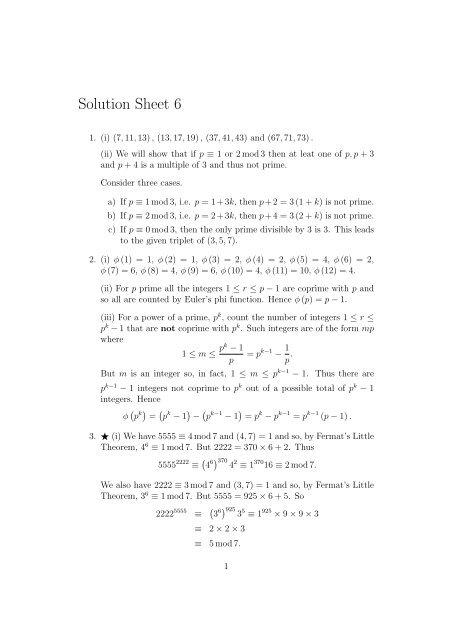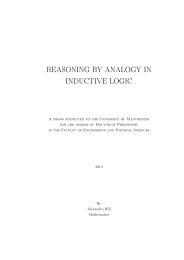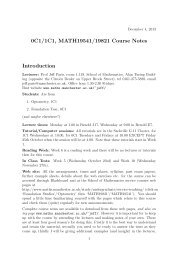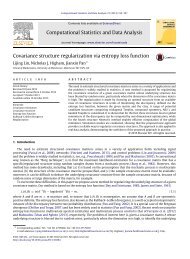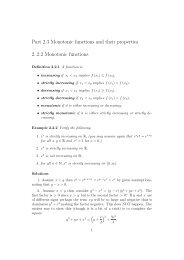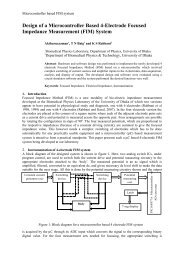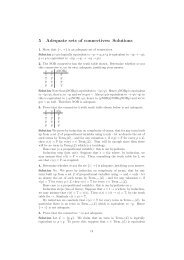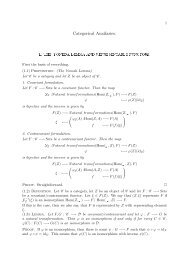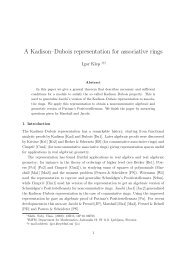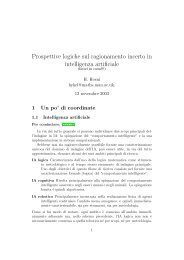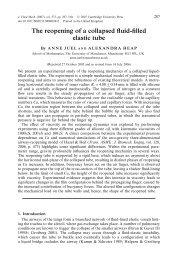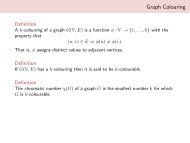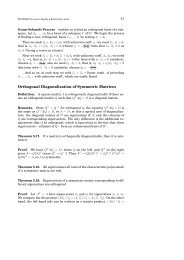Solution Sheet 6
Solution Sheet 6
Solution Sheet 6
You also want an ePaper? Increase the reach of your titles
YUMPU automatically turns print PDFs into web optimized ePapers that Google loves.
<strong>Solution</strong> <strong>Sheet</strong> 6<br />
1. (i) (7, 11, 13) , (13, 17, 19) , (37, 41, 43) and (67, 71, 73) .<br />
(ii) We will show that if p ≡ 1 or 2 mod 3 then at leat one of p, p + 3<br />
and p + 4 is a multiple of 3 and thus not prime.<br />
Consider three cases.<br />
a) If p ≡ 1 mod 3, i.e. p = 1 + 3k, then p + 2 = 3 (1 + k) is not prime.<br />
b) If p ≡ 2 mod 3, i.e. p = 2 + 3k, then p + 4 = 3 (2 + k) is not prime.<br />
c) If p ≡ 0 mod 3, then the only prime divisible by 3 is 3. This leads<br />
to the given triplet of (3, 5, 7).<br />
2. (i) φ (1) = 1, φ (2) = 1, φ (3) = 2, φ (4) = 2, φ (5) = 4, φ (6) = 2,<br />
φ (7) = 6, φ (8) = 4, φ (9) = 6, φ (10) = 4, φ (11) = 10, φ (12) = 4.<br />
(ii) For p prime all the integers 1 ≤ r ≤ p − 1 are coprime with p and<br />
so all are counted by Euler’s phi function. Hence φ (p) = p − 1.<br />
(iii) For a power of a prime, pk , count the number of integers 1 ≤ r ≤<br />
pk − 1 that are not coprime with pk . Such integers are of the form mp<br />
where<br />
1 ≤ m ≤ pk − 1<br />
p = pk−1 − 1<br />
p .<br />
But m is an integer so, in fact, 1 ≤ m ≤ p k−1 − 1. Thus there are<br />
p k−1 − 1 integers not coprime to p k out of a possible total of p k − 1<br />
integers. Hence<br />
φ p k = p k − 1 − p k−1 − 1 = p k − p k−1 = p k−1 (p − 1) .<br />
3. ⋆ (i) We have 5555 ≡ 4 mod 7 and (4, 7) = 1 and so, by Fermat’s Little<br />
Theorem, 4 6 ≡ 1 mod 7. But 2222 = 370 × 6 + 2. Thus<br />
5555 2222 ≡ 4 6 370 4 2 ≡ 1 370 16 ≡ 2 mod 7.<br />
We also have 2222 ≡ 3 mod 7 and (3, 7) = 1 and so, by Fermat’s Little<br />
Theorem, 3 6 ≡ 1 mod 7. But 5555 = 925 × 6 + 5. So<br />
2222 5555 ≡ 3 6 925 3 5 ≡ 1 925 × 9 × 9 × 3<br />
≡ 2 × 2 × 3<br />
≡ 5 mod 7.<br />
1
Hence<br />
(ii)<br />
5555 2222 + 2222 5555 ≡ 2 + 5 ≡ 0 mod 7.<br />
5555 2222 + 2222 5555 ≡ 2 2222 + 8 5555<br />
≡ 2 2222 + (−1) 5555<br />
≡ 2 2222 − 1 mod 9,<br />
using 5555 is odd. Then Fermat’s Little Theorem states that m 6 ≡<br />
1 mod 9 when (m, 9) = 1 since φ (9) = 6 from the solution to Question<br />
2. Since 2222 = 370 × 6 + 2 we get<br />
Hence<br />
2 2222 − 1 ≡ 2 6 370 2 2 − 1<br />
≡ 2 2 − 1 = 3 mod 9.<br />
5555 2222 + 2222 5555 ≡ 3 mod 9.<br />
Thus 5555 2222 + 2222 5555 is of the form 3 + 9ℓ for some ℓ ∈ Z. Here<br />
3 + 9ℓ = 3 (1 + 3ℓ) is a multiple of 3, i.e. divisible by 3, but not by 9.<br />
(iii) First<br />
3333 7777 + 7777 3333 ≡ 33 7777 + 77 3333 mod 100.<br />
But also m 40 ≡ 1 mod 100 if (m, 100) = 1 since φ (100) = 40m. Note<br />
that 7777 = 194 × 40 + 17 while 3333 = 83 × 40 + 13, so<br />
33 7777 + 77 3333 = 33 40 194 33 17 + 77 40 83 77 13<br />
since (33, 100) = (77, 100) = 1.<br />
≡ 33 17 + 77 13 mod 100,<br />
Finally, using the method of successive squaring we get 33 17 ≡ 73 mod 100<br />
and 77 13 ≡ 17 mod 100. Hence the last two digits of 3333 7777 + 7777 3333<br />
are 90.<br />
4. No. It is not well defined on Q. For instance,<br />
1 1<br />
∗<br />
2 1<br />
2<br />
= 2<br />
3 .
But in Q we have 1<br />
2<br />
= 2<br />
4 yet<br />
2 1<br />
∗<br />
4 1<br />
5. (i) No. 1 + 1 = 2 which is not odd.<br />
= 3<br />
5<br />
= 2<br />
3 .<br />
(ii) Yes. If a and b are even integers then a = 2k and b = 2ℓ for some<br />
integers k, ℓ. But then ab = (2k) (2ℓ) = 2 (2kℓ) is even.<br />
(iii) Yes. If a and b are odd integers then a = 2k + 1 and b = 2ℓ + 1 for<br />
some integers k, ℓ. Thus<br />
which is odd.<br />
a ◦ b = a + b − ab<br />
= 2k + 1 + 2ℓ + 1 − (2k + 1) (2ℓ + 1)<br />
= 2 (−2kℓ) + 1<br />
6. ⋆ (i) Is commutative. Proof: addition on R is commutative,<br />
Is not associative. Counterexample: 1 ∗ (2 ∗ 3) = 1 ∗ 10 = 22 while<br />
(1 ∗ 2) ∗ 3 = 18.<br />
(ii) Is not commutative. Counterexample: 1∗−1 = 1 while −1∗1 = −1.<br />
Is associative. Proof: a ∗ (b ∗ c) = a ∗ (b |c|) = a |b |c|| = a |b| |c| and<br />
(a ∗ b) ∗ c = (a |b|) ∗ c = a |b| |c| .<br />
(iii) Is commutative. Proof: both addition and multiplication are commutative<br />
on R.<br />
Is not associative. Counterexample:<br />
1 ∗ (2 ∗ 3) =<br />
(1 ∗ 2) ∗ 3 =<br />
1 + (2 ∗ 3)<br />
1 × (2 ∗ 3)<br />
(1 ∗ 2) + 3<br />
(1 ∗ 2) × 3 =<br />
= 1 + 2+3<br />
2×3<br />
2+3<br />
2×3<br />
1+2<br />
2<br />
1+2<br />
2<br />
+ 3<br />
= 11<br />
5 .<br />
= 9<br />
3 .<br />
(iv) Is commutative Proof: addition and multiplication are commutative<br />
on Z.<br />
3
Is associative. Proof:<br />
a ∗ (b ∗ c) = a ∗ (b + c − bc)<br />
= a + (b + c − bc) − a (b + c − bc)<br />
= a + b + c − bc − ab − ac + abc<br />
= a + b − ab + c − ac − bc + abc<br />
= (a + b − ab) + c − (a + b − ab) c<br />
= (a ∗ b) + c − (a ∗ b) c<br />
= (a ∗ b) ∗ c.<br />
(v) Is commutative, Proof: x ∗ y = max (x, y) = max (y, x) = y ∗ x.<br />
Is associative. Proof:<br />
x ∗ (y ∗ z) = max (x, y ∗ z) = max (x, max (y, z))<br />
= max (x, y, z) = max (max (x, y) , z)<br />
= max (x ∗ y, z) = (x ∗ y) ∗ z.<br />
(vi) Is not commutative. Counterexample: (1, 2) ∗ (3, 4) = (2, 6) but<br />
(3, 4) ∗ (1, 2) = (3, 10) .<br />
Is associative. Proof:<br />
((a, b) ∗ (c, d)) ∗ (e, f) = (ac, ad + b) ∗ (e, f)<br />
= ((ac) e, (ac) f + (ad + b))<br />
= (ace, acf + ad + b) ,<br />
(a, b) ∗ ((c, d) ∗ (e, f)) = (a, b) ∗ (ce, cf + d)<br />
(vii) Is commutative, Proof:<br />
= (a (ce) , a (cf + d) + b)<br />
= (ace, acf + ad + b) .<br />
(a, b) ∗ (c, d) = (ad + bc, db)<br />
4<br />
= (cb + da, bd)<br />
= (c, d) ∗ (a, b) .
Is associative. Proof:<br />
((a, b) ∗ (c, d)) ∗ (e, f) = (ad + bc, db) ∗ (e, f)<br />
= ((ad + bc) f + (db) e, f (db))<br />
= (adf + bcf + bde, bdf) .<br />
(a, b) ∗ ((c, d) ∗ (e, f)) = (a, b) ∗ (cf + de, fd)<br />
= (a (fd) + b (cf + de) , (fd) b)<br />
= (adf + bcf + bde, bdf) .<br />
7. (i) Yes. max (1, n) = max (n, 1) = n for any n ≥ 1 and so 1 is the<br />
identity.<br />
(ii) No. If e ∈ Z is an identity, then we can choose an integer x < e<br />
and for this integer we find that x ∗ e = max (x, e) = e = x.<br />
(iii) Yes. 0. We have seen that this x ∗ y is commutative so we need<br />
only examine x ∗ 0 = x + 0 − x × 0 = x.<br />
(iv) Yes.<br />
<br />
1<br />
2<br />
1<br />
2<br />
1<br />
2<br />
1<br />
2<br />
<br />
8. Many reasons. Perhaps because subtraction is not associative.<br />
9. ⋆ a)<br />
1 − (2 − 3) = 2 but (1 − 2) − 3 = −4.<br />
×15 1 4 7 13<br />
1 1 4 7 13<br />
4 4 1 13 7<br />
7 7 13 4 1<br />
13 13 7 1 4<br />
× A B C D<br />
A A B C D<br />
B B A D C<br />
C C D A B<br />
D D C B A<br />
5<br />
×15 3 6 9 12<br />
3 9 3 12 6<br />
6 3 6 9 12<br />
9 12 9 6 3<br />
12 6 12 3 9
where<br />
and<br />
10. a)<br />
A =<br />
1 0<br />
0 1<br />
<br />
1 0<br />
, B =<br />
0 −1<br />
D =<br />
−1 0<br />
0 −1<br />
<br />
−1 0<br />
, C =<br />
0 1<br />
(b) In ({1, 4, 7, 13} , ×15), the identity is 1 and the inverses are 4 −1 = 4,<br />
7 −1 = 13 and 13 −1 = 7.<br />
In ({3, 6, 9, 12} , ×15) the identity is 6 and the inverses are 9 −1 = 9,<br />
3 −1 = 12 and 12 −1 = 3.<br />
In the matrix group the identity is A and all matrices are self-inverse.<br />
The identity element is 8.<br />
<br />
.<br />
×28 4 8 12 16 20 24<br />
4 16 4 20 8 24 12<br />
8 4 8 12 16 20 24<br />
12 20 12 4 24 16 8<br />
16 8 16 24 4 12 20<br />
20 24 20 16 12 8 4<br />
24 12 24 8 20 4 16<br />
4 −1 = 16, 8 −1 = 8, 12 −1 = 24, 16 −1 = 4, 20 −1 = 20 and 24 −1 = 12.<br />
b) ({4, 8, 16} , ×28) is a closed subset.<br />
×28 4 8 16<br />
4 16 4 8<br />
8 4 8 16<br />
16 8 16 4<br />
6
({8, 20} , ×28) is a closed subset:<br />
×28 8 20<br />
8 8 20<br />
20 20 8<br />
7


